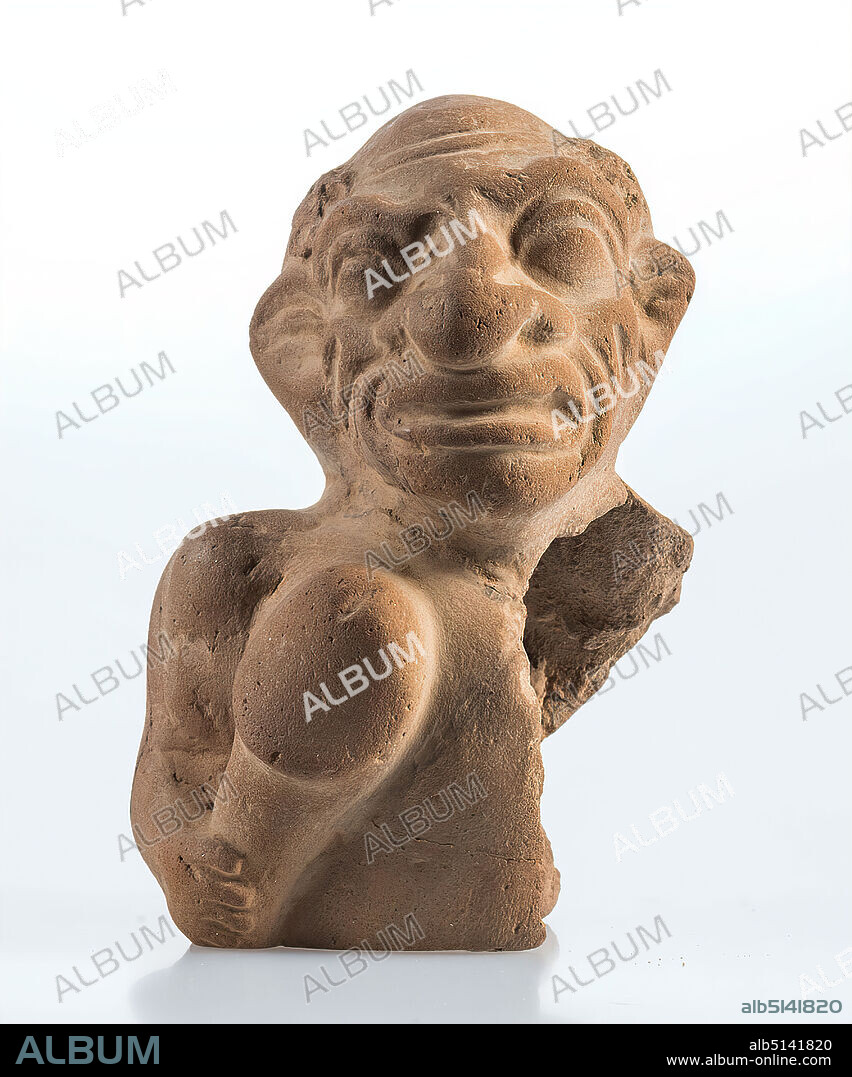alb5141820
Grotesque Man, clay, pressed into shape, hand modeled, fired (ceramic), clay, Total: Height: 10.2 cm; Width: 6.8 cm; Depth: 7.6 cm, ceramic, slavery; Slaves, penis, phallus, types of people, Hellenism, Early Imperial Period, Middle Imperial Period, The fragment of a Fayum terracotta with eyelet attached at the back shows the head and parts of the upper body of a man. It shows the typical tortured face of slaves or underclass; prominent features are the broad hooked nose, deep forehead and cheek wrinkles, thick lips and covered brow arches. The eyes are sharply contoured. A hair-wreath is indicated. A large phallus is clamped under the right arm. Lower body and the left side of the upper body are not preserved. The figure belongs to the group of the so-called Fayum terracottas. In Alexandria, the international, Greek-influenced center of Egypt, lives a multicultural society of Egyptians, Orientals, Greeks, Romans, Jews and others, whose different religious ideas are gradually blending together. Insights into this world of faith are provided by the so-called Fayum terracottas. They are part of the religious household, children's toys, knick-knacks, but also cult symbols, grave goods, pilgrimage images, votive offerings and magical objects for banishing evil forces. They can be found in houses, graves and sanctuaries.

|
Zu einem anderen Lightbox hinzufügen |
|
Zu einem anderen Lightbox hinzufügen |



Haben Sie bereits ein Konto? Anmelden
Sie haben kein Konto? Registrieren
Dieses Bild kaufen
Untertitel:
Siehe automatische Übersetzung
Grotesque Man, clay, pressed into shape, hand modeled, fired (ceramic), clay, Total: Height: 10.2 cm; Width: 6.8 cm; Depth: 7.6 cm, ceramic, slavery; Slaves, penis, phallus, types of people, Hellenism, Early Imperial Period, Middle Imperial Period, The fragment of a Fayum terracotta with eyelet attached at the back shows the head and parts of the upper body of a man. It shows the typical tortured face of slaves or underclass; prominent features are the broad hooked nose, deep forehead and cheek wrinkles, thick lips and covered brow arches. The eyes are sharply contoured. A hair-wreath is indicated. A large phallus is clamped under the right arm. Lower body and the left side of the upper body are not preserved. The figure belongs to the group of the so-called Fayum terracottas. In Alexandria, the international, Greek-influenced center of Egypt, lives a multicultural society of Egyptians, Orientals, Greeks, Romans, Jews and others, whose different religious ideas are gradually blending together. Insights into this world of faith are provided by the so-called Fayum terracottas. They are part of the religious household, children's toys, knick-knacks, but also cult symbols, grave goods, pilgrimage images, votive offerings and magical objects for banishing evil forces. They can be found in houses, graves and sanctuaries.
Persönlichkeiten:
Bildnachweis:
Album / quintlox
Freigaben (Releases):
Model: Nein - Eigentum: Nein
Rechtefragen?
Rechtefragen?
Bildgröße:
3596 x 4320 px | 44.4 MB
Druckgröße:
30.4 x 36.6 cm | 12.0 x 14.4 in (300 dpi)
Schlüsselwörter:
AEGYPTEN • AUGE • AUGE, SEHEN • AUGEN • DEKORATION • FORM • FRAGMENT • GLAUBE • GRUPPE • HAUS • HÄUSER • INTERNATIONAL • JUDE • JUDEN • JUEDISCH • KERAMIK • KOPF (ANATOMIE) • KOPF • LEUTE • MANN • MENSCHEN • NIPPES • ORNAMENT • ORNAMENTE • PENIS • SKLAVEREI • STEINGUT • TOEPFEREI • TOEPFERWARE • TON • TUMBAS • TÖPFEREI • VERZIEHRUNG • VERZIERUNG • WELT • ZIERDE • ÄGYPTEN
 Pinterest
Pinterest Twitter
Twitter Facebook
Facebook Link kopieren
Link kopieren Email
Email
